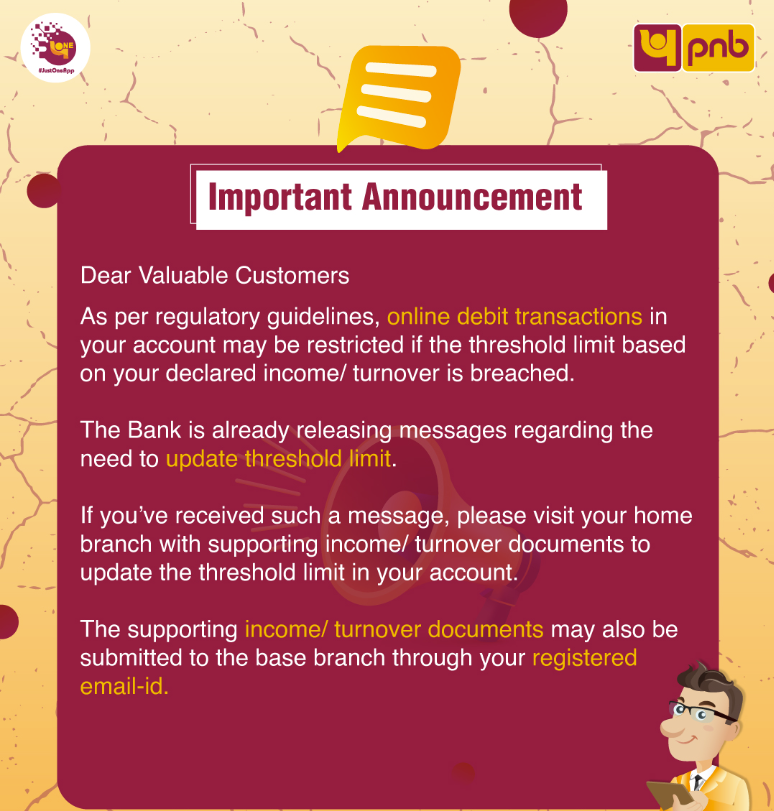
If you’re a customer of Punjab National Bank (PNB), you’ve probably come across the term “threshold limit”—especially if you’ve tried to make a large transaction and faced restrictions. But what exactly does threshold limit in PNB mean? Why is it important? And what can you do if you exceed it?
Let’s break it all down in simple terms.
What Is the Threshold Limit in PNB
The threshold limit in PNB refers to the maximum amount of money (credits) that can be received in your account within a specific period—usually annually or quarterly—based on your declared income or turnover.
This limit is set by the bank when you open your account and helps in:
- Ensuring your transactions align with your income or business.
- Preventing suspicious or fraudulent activity.
- Complying with KYC (Know Your Customer) and AML (Anti-Money Laundering) regulations.
How Is the Threshold Limit Calculated?
PNB sets this limit during the account opening process, based on:
- Your declared Annual Income or Turnover
- Expected Annual Credits (the amount you expect to receive in the account)
Here’s how it works:
| Type of Declaration | Credit Limit (Pro-rata Basis) |
|---|---|
| If you provide documents (like ITR, GST returns, salary slips) | 150% of your declared Expected Annual Credits |
| If you give a self-declaration (for example: housewife, student, or laborer) | Capped at ₹5 lakh (Savings Account) or ₹25 lakh (Current Account) |
| For BSBD (Basic Savings Bank Deposit) Accounts | Fixed limit of ₹2 lakh annually, no matter what |
Is the Limit Permanent?
No. The threshold limit in PNB is reviewed every year at the start of the financial year based on:
- Actual credit activity in the previous year
- Existing threshold
- Any changes in your income or business
You may also request an update by submitting new documents showing higher income or turnover.
What Happens If You Exceed the Threshold Limit?
Here’s what PNB does when your credits exceed the allowed threshold:
1. Regular Savings Accounts
When your total incoming credits reach the threshold set during account opening:
- PNB sends an SMS alert when you cross 80% of the threshold.
- When you exceed 100%:
- The bank displays an alert in its system.
- Only the branch head can approve further debit transactions.
- The bank requests you to submit documents (like salary slips, ITR, or income proof).
- After you submit the required documents, the branch updates your threshold limit and restores full transaction access.
2. BSBD (Basic Savings Bank Deposit) Savings Accounts
BSBD accounts are no-frills accounts with a fixed annual credit limit of ₹2 lakh.
When your total incoming money crosses ₹2 lakh in a financial year:
- PNB instantly blocks all online debit transactions (like UPI, NEFT, IMPS, mobile banking, etc.).
- You can still receive money into your account, but you can’t send money online.
- To continue using digital services:
- You must convert your BSBD account to a regular savings account.
- You need to submit updated KYC documents and income proof.
- The bank then sets a new threshold based on your income and restores online transaction access.
3. Current Accounts (Sole Proprietorship)
For sole proprietorship current accounts opened or re-activated on or after April 1, 2023, PNB sets a quarterly credit limit instead of an annual one.
When your total credits exceed the quarterly pro-rata threshold:
- PNB blocks all online debit transactions immediately—this includes IMPS, UPI, NEFT, and RTGS.
- The bank still allows credits to your account.
- You receive an SMS alert for every declined transaction.
- To resolve the issue:
- You must submit income/turnover documents to the branch.
- The branch reviews the documents and updates the threshold limit.
- If the situation is urgent, the Branch Incumbent (Manager) may allow the debit manually after proper verification.
- If you received a large one-time credit, like from a property sale, you can ask the branch to exclude that transaction from threshold calculation.
How to Manage or Increase Your Threshold Limit in PNB?
If you’re running a business or expecting large inflows, here’s what you should do:
Step 1: Submit Valid Documents
Provide proof of higher income or business turnover, such as:
- Income Tax Return (ITR)
- GST filings
- Salary slips
- Bank statements
Step 2: Visit Your Home Branch
Ask the branch to revise your threshold limit based on the new documents. They will use their system to update your limit in CBS.
Step 3: Follow Up
Once the branch verifies your documents, they’ll get approval from higher authorities, and your limit will be updated accordingly.
Can I Get Exemption for One-Time High Credit?
Yes, in certain cases.
If you receive a one-time high credit, like from property sales, insurance maturity, or inheritance, PNB allows branches to exclude such credits from threshold calculation. This prevents the system from blocking your transactions unfairly.
Just inform your branch and they’ll record it properly for exemption.
Why Is the Threshold Limit in PNB Important?
The threshold limit helps the bank:
- Monitor unusual or risky transactions.
- Prevent fraud and money laundering.
- Comply with RBI’s strict regulatory framework.
And for customers, it helps:
- Avoid account blocks or debit restrictions.
- Stay compliant with banking rules.
- Ensure smoother, uninterrupted banking.
Final Words: How to Avoid Issues
- Always declare your expected annual credits honestly at account opening.
- Submit valid documents (like ITR, GST returns, salary slips) to set a realistic threshold.
- Update your documents if your income or business grows.
- Respond quickly when the bank alerts you about crossing 80% or 100% of your limit.
The threshold limit in PNB protects your account and helps prevent fraud. If you manage it smartly, you’ll enjoy smooth and uninterrupted banking.
